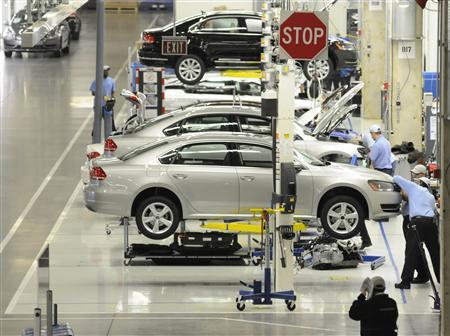 U.S. auto sales rose 14 percent in November, paced by gains at Chrysler Group LLC and Volkswagen AG, as consumers returned to showrooms even without the lure of a big year-end sale.
U.S. auto sales rose 14 percent in November, paced by gains at Chrysler Group LLC and Volkswagen AG, as consumers returned to showrooms even without the lure of a big year-end sale.
Chrysler and VW posted the highest percentage gains at 45 percent and 41 percent, respectively.
Others posting double-digit gains were Hyundai Motor Co at 22 percent, Nissan Motor Co at 19 percent, and Ford Motor Co at 13 percent. General Motors and Toyota Motor Co trailed with increases of 7 percent.
Honda Motor, which has been the slowest of the major Japanese automakers to recover from supply disruptions caused by the March earthquake, saw sales fall 6 percent.
The sales gain for Toyota was the first since April. Honda sales have been down every month since May, and the Japanese automaker has seen its U.S. market share tumble from almost 11 percent to just over 8 percent in the same period.
On an industry wide basis, sales exceeded analyst expectations at an annualized rate of 13.6 million, the highest sales rate since August 2009 when the U.S. government was running the “cash for clunkers” trade-in incentive program.
November also marked the third straight month that annualized vehicle sales have topped 13 million mark. Auto sales have been trending higher since June, despite the still weak employment and housing markets.
In an encouraging sign for industry profitability, the broad sales gains in November came despite lower spending on discounts by the automakers compared with a year earlier. The average vehicle price rose 4 percent to top $30,000, according to industry-tracking firm TrueCar.com.
Automakers were able to charge more for new cars because used cars were worth more at trade-in. Low-interest-rate loans also helped keep new vehicles affordable, analysts and executives said.
“The industry is really feeling some momentum right now, said John Krafcik, Hyundai Motor America’s president. “People are seeing there is more equity in their used cars than they had realized.”
The average vehicle on U.S. roads is almost 11 years old, two years older today than the average in 2007, when the U.S. auto industry began to tip into a downturn.
PENT-UP DEMAND
For more than a year, analysts have been predicting that many older cars would begin to break down beyond the point of cheap repairs, spurring replacement sales even without a broader upturn in the economy.
“I think it’s easy to underestimate the pent-up demand that’s out there,” said Paul Ballew, chief economist for insurer Nationwide.
As a share of overall U.S. consumer spending, spending on vehicles is down to 3.5 percent in 2011 from a long-term average of near 6 percent, Ballew said. In the depth of the 1982 recession, it was 4.5 percent.
“We are starting to see more and more of this pent-up demand realized,” said Ford economist Jenny Lin.
Analysts and some auto executives said American consumers appear to be willing to make big-ticket purchases when necessary, despite uncertainties like the economic outlook in Europe.
“The biggest change in the consumer attitude is that a lot of consumers are now realizing this uncertainty in the market is not going to disappear completely any time soon,” TrueCar.com analyst Jesse Toprak said. “It’s a big mind shift, which is positive for the industry.”
Another positive development for U.S. automakers was the rise in sales of trucks, including work vans and SUVs. Those larger vehicles remain more profitable than the smaller passenger cars where Detroit automakers are making a push to compete.
Sales of pickup trucks, watched as an indicator for a recovery in sentiment and spending by small businesses, including construction firms, were up in November.
Sales of Ford’s F-Series, which includes the top-selling F-150 pickup truck, shot up 24 percent, making it the best monthly performance for the brand since 2006.
At GM, sales to small businesses were up 16 percent, led by the company’s Chevrolet and GMC trucks. Sales of GM’s most popular pickup trucks, the Chevy Silverado and GMC Sierra, were up 31 percent.
“Small business owners need to replace their fleets, and some of these vehicles are near the end of their useful lives,” said Alan Batey, head of GM’s Chevy brand.
Source : Reuters




































